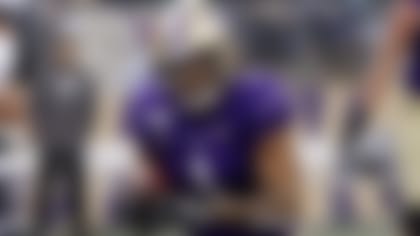The first time K.J. Hamler put on the Catapult vest before a practice at Penn State, it didn't feel like something suited for football. It felt rather restrictive.
What is this? Hamler thought to himself. It's like I'm wearing a bra.
After a few days with the harness under his pads, Hamler didn't even notice it anymore. The Nittany Lions wide receiver carried it with him while running routes, taking the ball on end-arounds, returning kicks and blowing past defenders in the open field on the way to the end zone -- all the while, the GPS tracking device inside the vest relayed his speed to the Penn State sports-science staff, who track Catapult data output for all players, during practices and games.
Now, with the 2020 NFL Draftless than a month away, Hamler -- a projected second-round pick by many, including Chad Reuter in his latest NFL.com mock -- is thankful for that once awkward-fitting vest.
With the scouting process affected by the travel restrictions put in place by the NFL, as well as college schools and athletic programs, due to the coronavirus pandemic, Hamler is one of hundreds of players who won't get the chance to display their skills the way prospects usually do. Hamler, who caught 56 passes for 904 yards (16.1 yards per catch) and eight touchdowns last fall, didn't run at the NFL Scouting Combine because of a hamstring injury he'd suffered in training. And his pro day, like those of most draft-eligible players, was canceled as teams started pulling their scouts off the road and campuses began closing down.
So what's a speed receiver to do when he can't run the 40-yard dash and perform agility drills for teams? Rely on technology, of course.
Hamler's agents at CAA requested his GPS information from Penn State's sports-science staff and highlighted the receiver's top speed while carrying the football from each of his two college seasons (21.76 mph as a redshirt freshman in 2018 and 21.58 mph this past season). They plugged that data into the list of the top speeds for ball carriers in the NFL last season, as compiled by Next Gen Stats, putting Hamler in a tie for eighth and 13th, respectively. (The 22.30 mph 49ers running back Matt Breida posted on an 83-yard touchdown against the Browns tops the list.) They are planning to send that list to NFL teams this week to show them that, yes, the speed they see on film when they're watching Hamler's tape is NFL-caliber.
"You didn't even realize how fast you were going until you read the GPS, so it's like, 'Wow,' " Hamler said by phone last week. "It's a blessing to be a part of those (NFL) guys."
The intriguing part for NFL talent evaluators is Hamler believes the numbers don't show the full potential of his speed.
The two plays on which the GPS readings were taken were a 93-yard touchdown against Ohio State in 2018 and a 100-yard kickoff return against Michigan last October that was brought back by a holding penalty.
"I for sure slowed up on that one," Hamler said of the kick return, which one Twitter user timed in under 11 seconds.
Of the catch-and-run vs. the Buckeyes, on which former Ohio State safety Isaiah Pryor clearly underestimated Hamler's speed and took a bad angle, Hamler said, "I didn't know how to pick up my knees when I was running back then, so I was for sure running slower on that one."
Hamler has worked to perfect his running form in recent months with Anthony Hobgood, a performance manager at EXOS in Gulf Breeze, Florida. Hobgood has been working with NFL hopefuls for 12 years, and says Hamler's speed rivals that of maybe the fastest player he's ever trained at his facility.
"DeSean Jackson -- K.J. has that kind of speed," Hobgood said, comparing the 5-foot-9, 178-pound Hamler to the 5-10, 175-pound Jackson. "The difference is K.J. is a little stronger than him, especially in his upper body. DeSean struggled to bench press 225 (pounds) one time; K.J. did it 15 times. So not only does K.J. have that elite-level speed -- he also has tremendous upper-body strength to go along with that."
Hobgood said Hamler's 40 time when he arrived at EXOS to begin training was an electronically timed 4.36. As the staff continued to track Hamler's progress both in the 0-to-20-yard and 20-to-40-yard portion of his runs, they projected he would run in the mid-4.2s at the combine, which would've put him in the running for the fastest time in Indy this year. (Alabama receiver Henry Ruggs III took the honor with a 4.27.)
But Hamler didn't get the chance because one day, while running "flying 20s" (timed 20-yard dashes beginning at full speed to work on maintaining speed on the back end of the 40), Hamler tweaked his hamstring. The players were slated to run three reps and Hamler posted an electronically timed 1.80 on his second rep -- one of the fastest times the EXOS staff has ever seen. With a time like that already in the books, Hobgood told Hamler he could sit out the third attempt. But Hamler's competitive nature kicked in, as he wanted to see if he could dip into the 1.7s.
"He ran it, all the way through. Didn't pull up," Hobgood said. "And as he's slowing down, I see him put his hand on his hamstring and I'm like, 'Oh man.' "
Hobgood knew at that moment Hamler's combine was in jeopardy.
What Hobgood and pretty much everyone didn't realize at the time was the entire pre-draft process would be altered by the COVID-19 outbreak. Hamler was fully recovered from his injury and ready to run on March 17 -- the scheduled date of Penn State's pro day -- but the event had been canceled five days prior.
So Hamler has spent the past few weeks working out at home while talking to teams via teleconference instead of in person. He says he's done one interview almost every day since the scouting circuit shut down, including with the Ravens and Eagles in recent days. Given the fact he played at Penn State, is close friends with former Nittany Lions running back Miles Sanders and knows the Eagles will likely draft a wide receiver early, Philly seems to be an intriguing destination.
But many other teams are surely enamored with his speed. And quickness. Don't discount that last part, Hamler notes. The GPS readings are nice, but they only show top speed in the open field. There's more to football than that, and creating separation begins before players are in full stride.
Hamler notes short-area quickness is also a big part of his game and credits Broncos wide receiver DaeSean Hamilton (his teammate at Penn State during his redshirt year) with helping him dissect defenses, allowing his mind to work as quickly as his body.
"There are a lot of guys out here who are quick and fast, but not a lot of guys who have both," Hamler said. "I'm blessed to have those as my two best assets."
As for the GPS, some teams have embraced the added data, while others have said they'll trust what they see on film. After all, that's what they did last year when they studied a player with a similar build and skill set to Hamler's who didn't get to run in the spring -- Ravens receiver Marquise Brown, whom Baltimore selected 25th overall despite a lack of a timed 40 because he was recovering from foot surgery.
"My tape says it all. I'm very confident in my tape," Hamler said, adding with a laugh: "But it would be nice to have a time, so coaches would stop asking me what I would've run."
Follow Mike Garafolo on Twitter @MikeGarafolo.












